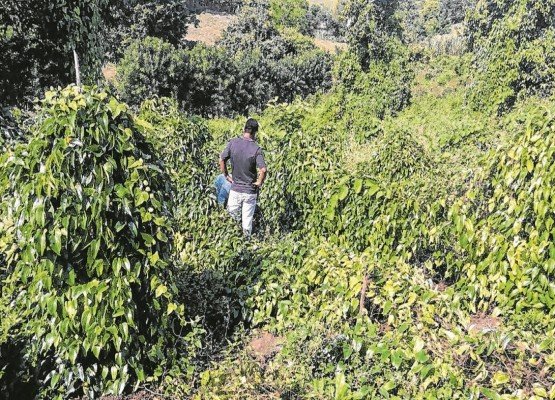Common name: White yam, yam
Scientific name: Dioscorea alata
Family: Dioscoreaceae
The Yam.
The yam is an herbaceous and edible plant that makes up the genus Dioscorea, of the family of the Discoreáceas (Dioscoreaceae), original and common tropical and subtropical regions around the world is a climbing herb of dioecious flowers. Some 180 species of dioscores are known, typical of warm countries. All are perennial herbs, with hairless stems, fickle that can reach large dimensions; with roots or fleshy rhizomes, sometimes very thick, which constitute underground tubers of high nutritional value.
Main species
The genus Dioscorea is very broad, the most outstanding species are:
Dioscorea rotundata: (white yam) native to West Africa. It is the largest area in the world.
Dioscorea cayenensis: (yellow yam).
Dioscorea alata: (large yam or water yam) native to Southeast Asia but is dispersed in almost all tropical and subtropical zones
Dioscorea opposita.
Dioscorea bulbífera. It is the only native species of Asia and Africa and is characterized by the large number of aerial bulbils per plant
Dioscorea esculenta. This species is native to Indo-China
Dioscorea dumetorum.
Dioscorea trífida: (Mapuey) native to Tropical America.
Dioscorea batata: Mexican yam.
Origin
Native and common to tropical and subtropical regions around the world

Conditions for its cultivation
This root and tuber crop should be planted in low regions, with precipitation conditions between 1,200 mm and 1,300 mm per year, and distributed throughout the year. Temperatures between 18 ºC and 34 ºC are required, and as for its soil it must be fertile, deep, loose, without stones and with good water drainage.
Characteristics
Yam is a root that has been used as a traditional food and medicine, since its complex chemical composition gives it a lot of benefits. also known as yame ynam, ycname of Guinea, ubi of the Philippines, dioscorea, purple yam ..., is a climbing herb of the Dioschoraceae family. Of dioecious flowers. Some 180 species of dioscores are known, typical of warm countries. All of them are perennial herbs, with hairless stems, fickle that can reach large dimensions; with roots or fleshy rhizomes, sometimes very thick, which constitute underground tubers of high nutritional value.
- Its leaves are alternate or almost opposite, have a digito-reticulate, petiolate, ovate-cordiform nerves. Its flowers are white, purple or green and little apparent, arranged in panicles, spikes or axillary racemes. The fruit is a pubescent, trialated capsule. All these plants produce long tubercles, fusiform, somewhat tortuous and formed internally by parenchymal tissues rich in starch, which are used for this reason for the feeding of man and domestic animals, for which they are prepared and seasoned in a way similar to potatoes (tuber).
- The yam belongs to the class of plants that grow to store edible material in the root, corma or underground tuber, this class is well known as roots and tubers. The yam is a tuber that is widely used for food, is of great importance in the daily diet of many peoples of the world.
- This plant is characterized by green and flimsy stems, fickle, 3 to 4 m long and quadrangular and winged, large heart-shaped leaves, small white flowers, greenish yellow or green in axillary spikes or clusters, and root large and tuberculous. Depending on the variety, its flesh can be white, yellow, purple or pink, and the skin from whitish to dark chocolate. Its texture can vary from soft and moist to rough, dry and mealy.
- The harvest is made 7-9 months after sowing, the foliage begins to dry, the tuber is mature when it has its characteristic color (depends on the variety that it is). It is important to avoid the long exposure of the tubers to the sun, as these deteriorate.
- Yam is a food rich in carbohydrates, proteins and an appreciable amount of vitamin C and vitamin B1. It supplies a substantial part of the manganese and phosphorus needs in adults and, to a lesser extent, also copper and magnesium. It is usually eaten boiled, roasted or mashed.
Generalities of cultivating
The Tropical Viandas Research Institute (INIVIT), based on the genetic improvement program, has developed a group of clones with potential for its introduction into production, focusing mainly on characters of interest to producers such as: yield, tolerance to pests and culinary quality, within this group highlights the clone 'INIVIT Ñ 2008', selected from the accession 'Filipino Cáscara Fina', for being a cultivar that produces aerial bulbils and presents an excellent quality for consumption .
Characteristics of the clone
The plant can present from two to three thick stems, of long internodes, with four edges and absence of thorns. The petioles are green, more than 10 cm long, with five edges and large stipules at the base. The foliage of the clone is abundant with simple leaves, heart-shaped acuminate, green, alternate, with eight ribs. It responds well to the application of organic matter (30 t.ha-1). It is moderately susceptible to anthracnose and tolerant to the effects produced by nematodes. The cycle for the harvest is 10 to 12 months. The tubers have a smooth texture and a cylindrical shape, a character that is uncommon in the cultivars of the Dioscorea high L. species conserved in Cuba (INIVIT), the coloration of the tuber mass is white, with excellent culinary quality, generally presents one or two tubers per plant. Produces aerial bulbils, which constitute an excellent material of plantation that allows not having to sacrifice between 30 and 40 qq / ha of commercial tubers for this purpose.